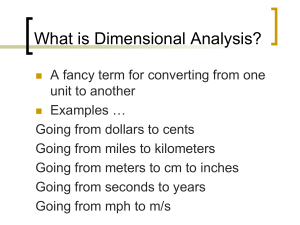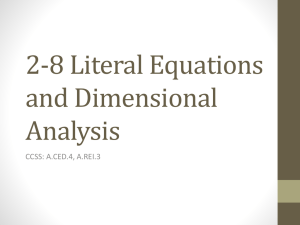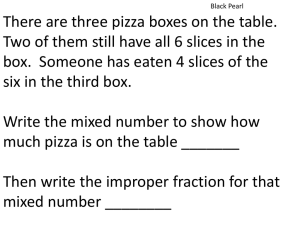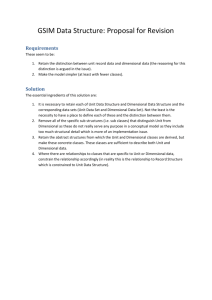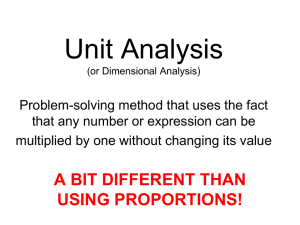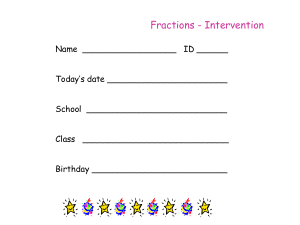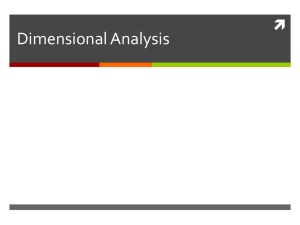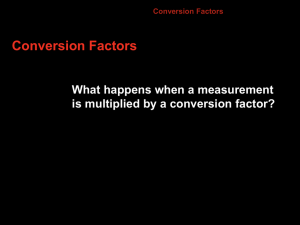Dimensional analysis powerpoint
advertisement
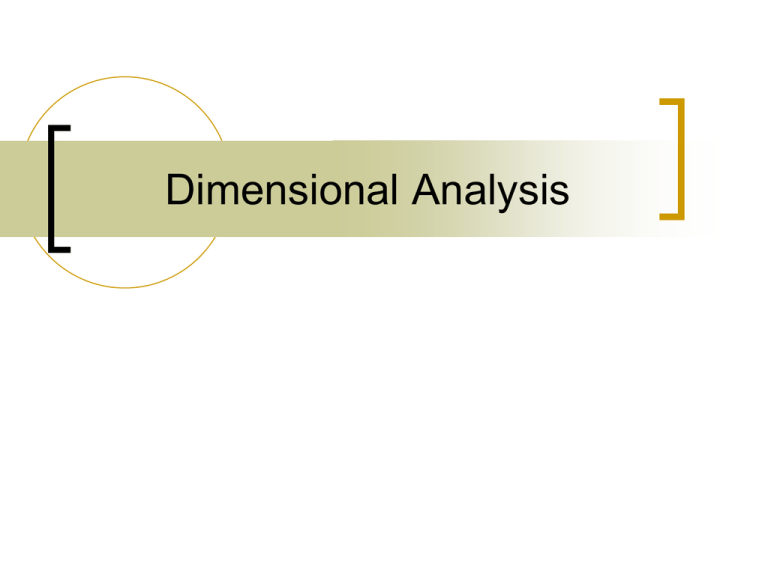
Dimensional Analysis What is Dimensional Analysis? Have you ever used a map? Since the map is a small-scale representation of a large area, there is a scale that you can use to convert from small-scale units to large-scale units—for example, going from inches to miles or from cm to km. What is Dimensional Analysis? Ex: 3 cm = 50 km What is Dimensional Analysis? Have you ever been to a foreign country? One of the most important things to do when visiting another country is to exchange currency. For example, one United States dollar equals 1535.10 Lebanese Pounds. What is Dimensional Analysis? Whenever you use a map or exchange currency, you are utilizing the scientific method of dimensional analysis. What is Dimensional Analysis? Dimensional analysis is a problemsolving method that uses the idea that any number or expression can be multiplied by one without changing its value. It is used to go from one unit to another. How Does Dimensional Analysis Work? A conversion factor, or a fraction that is equal to one, is used, along with what you’re given, to determine what the new unit will be. How Does Dimensional Analysis Work? In our previous discussions, you could say that 3 cm equals 50 km on the map or that $1 equals 1535.10 Lebanese Pounds (LBP). How Does Dimensional Analysis Work? If we write these expressions mathematically, they would look like 3 cm = 50 km $1 = 1535.10 LBP Examples of Conversions 60 s = 1 min 60 min = 1 h 24 h = 1 day Examples of Conversions You can write any conversion as a fraction. Be careful how you write that fraction. For example, you can write 60 s = 1 min as 60s or 1 min 1 min 60 s Examples of Conversions Again, just be careful how you write the fraction. The fraction must be written so that like units cancel. Steps 1. 2. 3. 4. 5. Start with the given value. Write the multiplication symbol. Choose the appropriate conversion factor. The problem is solved by multiplying the given data & their units by the appropriate unit factors so that the desired units remain. Remember, cancel like units. Let’s try some examples together… 1. Suppose there are 12 slices of pizza in one pizza. How many slices are in 7 pizzas? Given: 7 pizzas Want: # of slices Conversion: 12 slices = one pizza Solution Check your work… 7 pizzas 1 X 12 slices 1 pizza = 84 slices Let’s try some examples together… 2. How old are you in days? Given: 17 years Want: # of days Conversion: 365 days = one year Solution Check your work… 17 years 1 X 365 days 1 year = 6052 days Let’s try some examples together… 3. There are 2.54 cm in one inch. How many inches are in 17.3 cm? Given: 17.3 cm Want: # of inches Conversion: 2.54 cm = one inch Solution Check your work… 17.3 cm 1 X 1 inch 2.54 cm = Be careful!!! The fraction bar means divide. 6.81 inches Now, you try… 1. Determine the number of eggs in 23 dozen eggs. 2. If one package of gum has 10 pieces, how many pieces are in 0.023 packages of gum? Multiple-Step Problems Most problems are not simple one-step solutions. Sometimes, you will have to perform multiple conversions. Example: How old are you in hours? Given: 17 years Want: # of days Conversion #1: 365 days = one year Conversion #2: 24 hours = one day Solution Check your work… 17 years 1 X 365 days 1 year X 24 hours 1 day 148,920 hours = Combination Units Dimensional Analysis can also be used for combination units. Like converting km/h into cm/s. Write the fraction in a “clean” manner: km/h becomes km h Combination Units Example: Convert 0.083 km/h into m/s. Given: 0.083 km/h Want: # m/s Conversion #1: 1000 m = 1 km Conversion #2: 1 hour = 60 minutes Conversion #3: 1 minute = 60 seconds Solution Check your work… 0.083 km 1 hour 83 m 1 hour X 1000 m 1 km X 1 hour 60 min = X 0.023 m sec 83 m 1 hour 1 min 60 sec = Now, you try… Complete your assignment by yourself. If you have any questions, ask me as I will be walking around the room.

